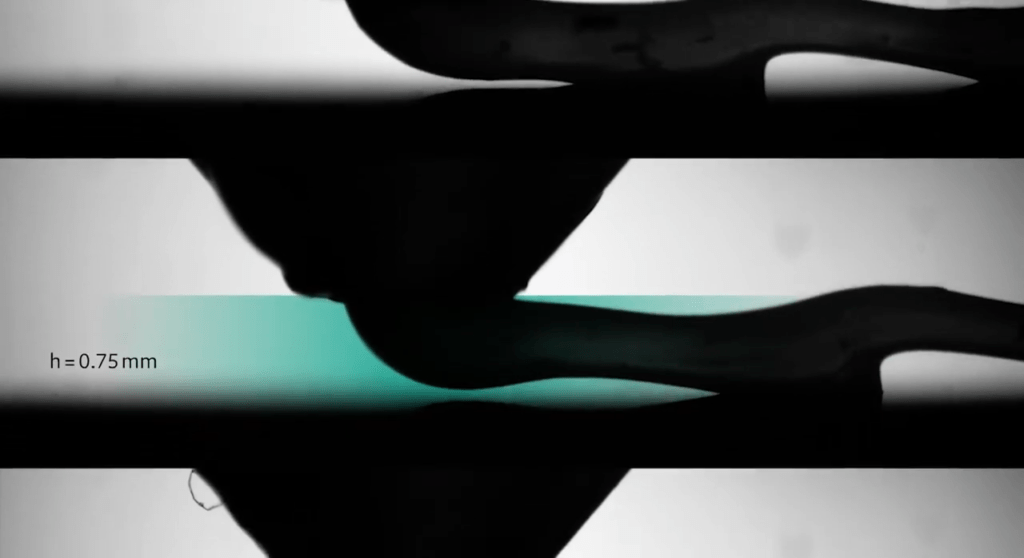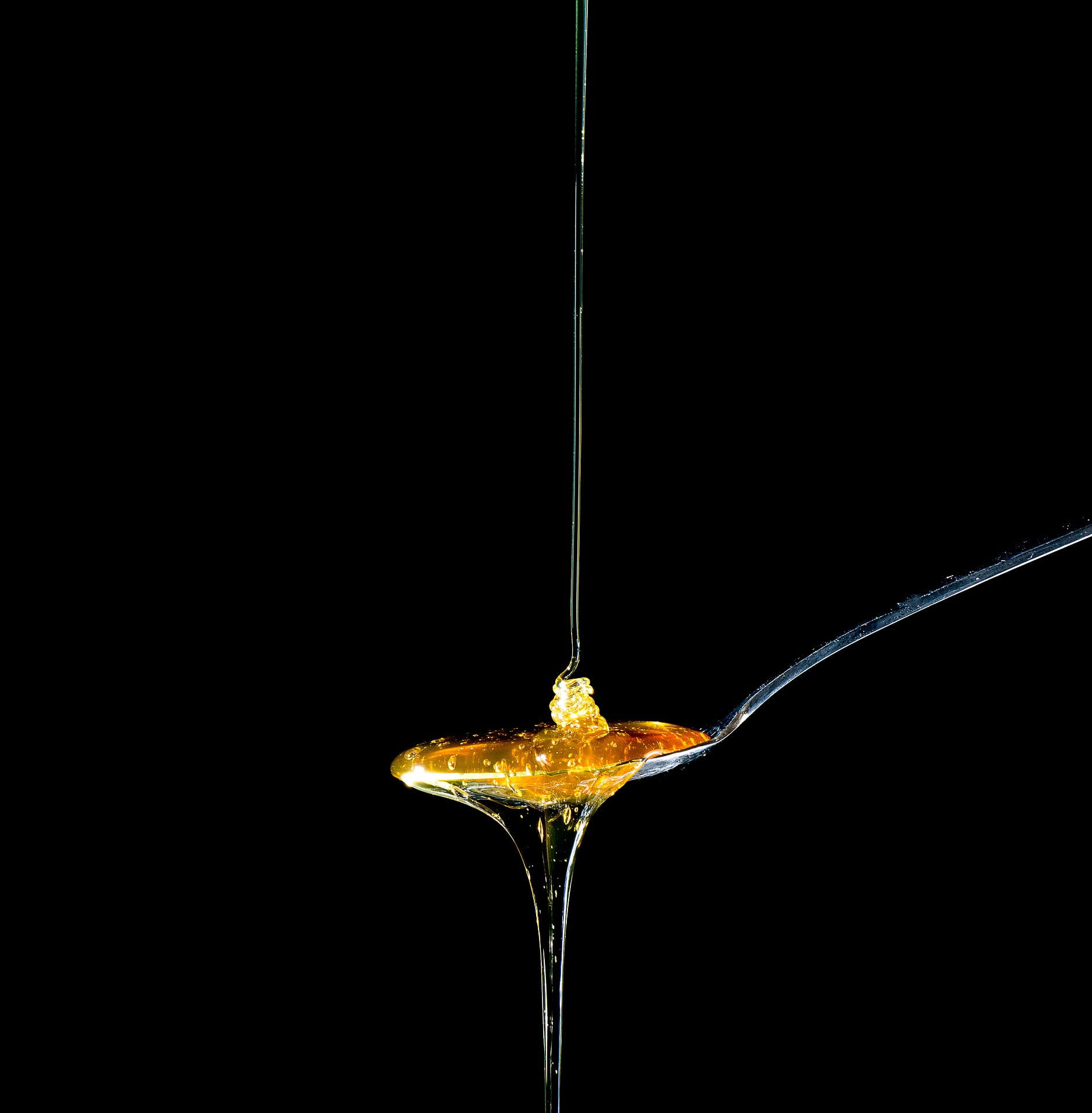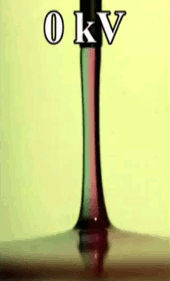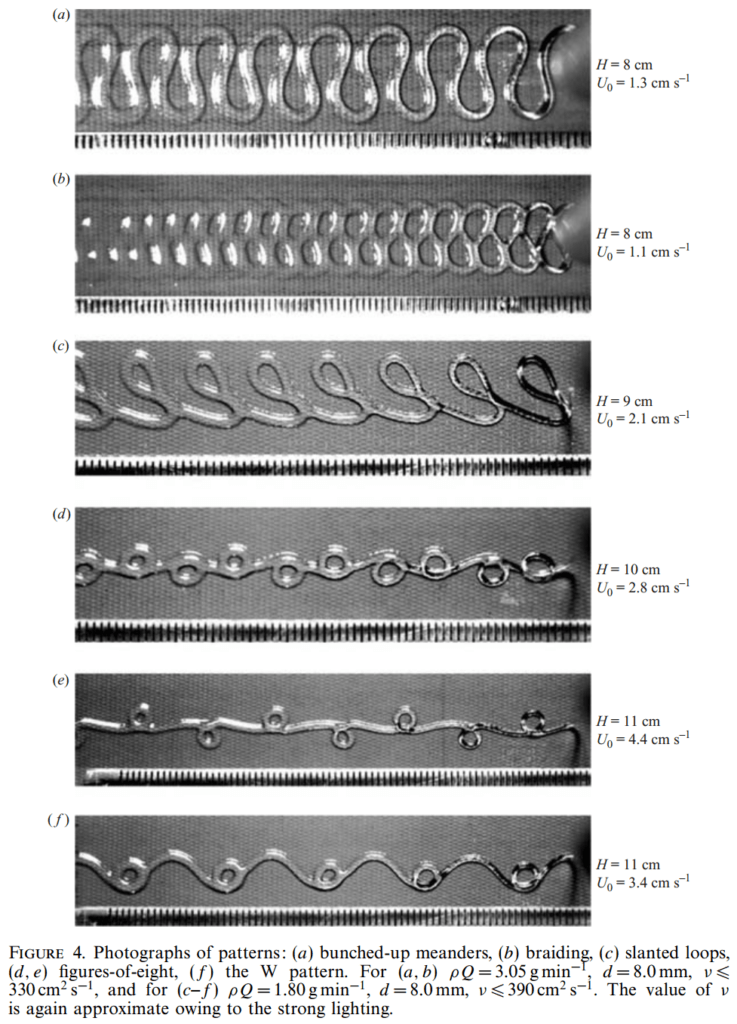3D printers are a neat apparatus for exploring flow instabilities. If too much material is extruded compared to the speed of the printer head, coiling takes place. But under-extrusion creates patterns, too. Here, researchers show how under-extrusion can create a stable lace-like pattern. Once dried, the material can stretch, but only in certain directions, a bit like many textiles. (Video and image credit: L. Dreier et al.)
Tag: coiling

Viscoelastic Coiling
Drizzle honey or syrup from high enough, and you’ll see it coil like a liquid rope. This feature of viscous fluids also extends to polymer-filled viscoelastic fluids. But recent work shows that the elasticity of these fluids delays the onset of coiling; put differently, if you pour two fluids of comparable viscosity, the viscoelastic one will have to fall farther before it will start coiling. The authors also found that the coiling frequency for a viscoelastic fluid is smaller than a viscous one, given the same experimental conditions. (Image credit: flo222; research credit: Y. Su et al.)

Pollock Avoided Coiling

Artists are often empirical masters of fluid dynamics, as they must be to achieve the effects they want. Jackson Pollock was particularly known for his so-called dripping technique, in which he dropped filaments of paint from brushes, cans, and even syringes as he moved around a horizontal canvas. (Scientifically speaking, this wasn’t really dripping since the paint wasn’t breaking up into droplets for the most part, but that’s another story.)
What Pollock was doing, fluid dynamically speaking, is the subject of a new study. Researchers analyzed historical footage of Pollock painting to measure the typical heights from which he dropped paint and the speed at which he moved. Then they built their own apparatus to mimic the painting style with modern paints and study the flow regime Pollock’s technique falls into.
Since much of the paint falls in a steady stream, like syrup falling onto pancakes, the researchers wondered whether the paint was likely to coil the way other viscous fluids do. What they found, however, is that Pollock’s choice of height and speed when applying paint seems deliberately designed to avoid the coiling instability. That fact suggests that art historians might identify forged paintings in part from the presence of too much coiling among the paint filaments. (Image credits: photo – M. Holmes/LIFE, painting – J. Pollock; research credit: B. Palacios et al; via Ars Technica; submitted by Kam-Yung Soh)

The Fluid Dynamical Sewing Machine
If you’ve drizzled viscous liquids like honey or syrup, you’ve no doubt witnessed their ability to coil. Combine that coiling with a moving platform and you form a system known as the fluid dynamical sewing machine, which creates different consistent patterns of loops and curves depending on the speed at which the liquid falls and the velocity of the moving platform. The predictability of these patterns makes them especially useful for 3D printing. Previously a group at MIT developed a glass printer that could use the instability, and here a group from Montreal demonstrates how they can build solid coils at various scales. Their video also explores what the structural properties of such coils are after they solidify. (Image, video, and research credit: R. Passieux et al.)

Electric Coiling
A falling jet of viscous fluid–like honey or syrup–will often coil. This happens when the jet falls quickly enough that it gets skinnier and buckles near the impact point. Triggering this coiling typically requires a jet to drop many centimeters before it will buckle. In many manufacturing situations, though, one might want a fluid to coil after a shorter drop, and that’s possible if one applies an electric field! Charging the fluid and applying an electric field accelerates the falling jet and induces coiling in a controllable manner.
An especially neat application for this technique is mixing two viscous fluids. If you’ve ever tried to mix, say, food coloring into corn syrup, you’ve probably discovered how tough it is to mix viscous substances. But by feeding two viscous fluids through a nozzle and coiling the resulting jet, researchers found that they could create a pool with concentric rings of the two liquids (see Figure C above). If you make the jet coil a lot, the space between rings becomes very small, meaning that very little molecular motion is necessary to finish mixing the fluids. (Image credits: T. Kong et al., source; via KeSimpulan)

The Kaye Effect
When a viscous fluid falls onto a surface, it will form a heap, like honey coiling. But for shear-thinning liquids like soap or shampoo something a little wild can happen as the heap grows. A dimple can form and, when the incoming jet of fluid hits that dimple, it slips against it and is ejected outward. If you wonder why you don’t see this every day in the shower, it’s because the outgoing jet usually hits the incoming jet, causing the whole system to collapse in less than 300 ms. By dropping the fluid on an inclined surface, one can keep the two jets from colliding, thereby creating a stable Kaye effect. (Photo credit: E. Eichelberger)

The Fluid Dynamical Sewing Machine
Anyone who has poured a viscous fluid like honey or syrup will have noticed its tendency to coil like rope. A similar effect is observed when a viscous fluid stream falls onto a moving belt. The photos above show some of the patterns seen in these “fluid-mechanical sewing machines” depending on the height of the thread and the speed of the moving belt. Notice how some of the patterns are doubles of another (i.e. two coils per side instead of one). This period doubling behavior is often seen in systems on their way to chaos. (Photo credits: S. Chiu-Webster and J. Lister)

Honey Coiling
The liquid rope coiling effect occurs in viscous fluids like oil, honey, shampoo, or even lava when they fall from a height. The exact behavior of the coil depends on factors like the fluid viscosity, the height from which the fluid falls, the mass flow rate, and the radius of the falling jet. Here Destin of the Smarter Every Day series outlines the four regimes of liquid coiling behavior commonly observed. As with many problems in fluid dynamics the regimes are described in terms of limits, which can help simplify the mathematics. The viscous regime (2:34 in the video) exists in the limit of a small drop height, whereas the inertial regime (3:15) exists in the limit of large drop height. Many complicated physical problems, including those with nonlinear dynamics, are treated in this fashion. For more on the mathematics of the coiling effect, check out Ribe 2004 and Ribe et al. 2006. (Video credit: Destin/Smarter Every Day; submitted by inigox5)

Pāhoehoe Lava
Lava flows come in many varieties but one of the most captivating is the pāhoehoe flow, meaning “smooth, unbroken lava” in the native Hawaiian. This type of basaltic lava features a smooth or undulating surface formed by the fluid lava beneath a cooler, congealing surface crust. They often feature low viscosity (by the standards of lava) and very high temperatures between 1100 and 1200 degrees Celsius. Here the flow shows features of viscous fluids like honey, including rope-coiling motions.

Viscous Fluid Falling on a Moving Belt
In this video a very viscous (but still Newtonian) fluid is falling in a stream onto a moving belt. Initially, the belt is moving quickly enough that the viscous stream creates a straight thread. As the belt is slowed, the stream begins to meander sinusoidally and ultimately begins to coil. Aside from some transient behavior when the speed of the belt is changed very quickly, the behavior of the thread is very consistent within a particular speed regime. This is indicative of a nonlinear dynamical system; each shift in behavior due to the changing speed of the belt is called a bifurcation and can be identified mathematically from the governing equation(s) of the system. (Video credit: S. Morris et al)


















